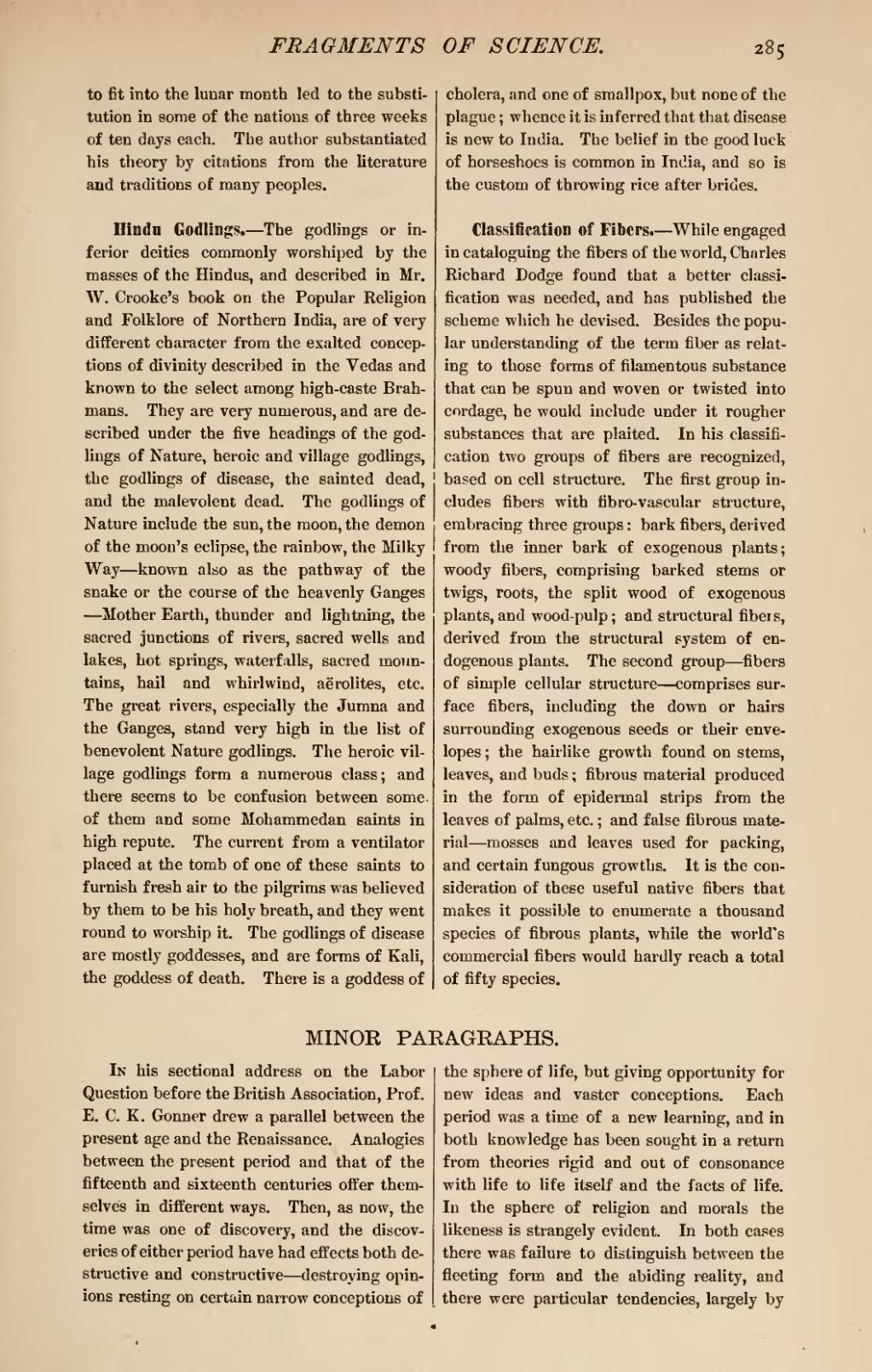to fit into the lunar month led to the substitution in some of the nations of three weeks of ten days each. The author substantiated his theory by citations from the literature and traditions of many peoples.
Hindu Godlings.—The godlings or inferior deities commonly worshiped by the masses of the Hindus, and described in Mr. W. Crooke's book on the Popular Religion and Folklore of Northern India, are of very different character from the exalted conceptions of divinity described in the Vedas and known to the select among high-caste Brahmans. They are very numerous, and are described under the five headings of the godlings of Nature, heroic and village godlings, the godlings of disease, the sainted dead, and the malevolent dead. The godlings of Nature include the sun, the moon, the demon of the moon's eclipse, the rainbow, the Milky Way—known also as the pathway of the snake or the course of the heavenly Ganges—Mother Earth, thunder and lightning, the sacred junctions of rivers, sacred wells and lakes, hot springs, waterfalls, sacred mountains, hail and whirlwind, aerolites, etc. The great rivers, especially the Jumna and the Ganges, stand very high in the list of benevolent Nature godlings. The heroic village godlings form a numerous class; and there seems to be confusion between some, of them and some Mohammedan saints in high repute. The current from a ventilator placed at the tomb of one of these saints to furnish fresh air to the pilgrims was believed by them to be his holy breath, and they went round to worship it. The godlings of disease are mostly goddesses, and are forms of Kali, the goddess of death. There is a goddess of cholera, and one of smallpox, but none of the plague; whence it is inferred that that disease is new to India. The belief in the good luck of horseshoes is common in India, and so is the custom of throwing rice after brides.
Classification of Fibers.—While engaged in cataloguing the fibers of the world, Charles Richard Dodge found that a better classification was needed, and has published the scheme which he devised. Besides the popular understanding of the term fiber as relating to those forms of filamentous substance that can be spun and woven or twisted into cordage, he would include under it rougher substances that are plaited. In his classification two groups of fibers are recognized, based on cell structure. The first group includes fibers with fibro-vascular structure, embracing three groups: bark fibers, derived from the inner bark of exogenous plants; woody fibers, comprising barked stems or twigs, roots, the split wood of exogenous plants, and wood-pulp; and structural fibers, derived from the structural system of endogenous plants. The second group—fibers of simple cellular structure—comprises surface fibers, including the down or hairs surrounding exogenous seeds or their envelopes; the hairlike growth found on stems, leaves, and buds; fibrous material produced in the form of epidermal strips from the leaves of palms, etc.; and false fibrous material—mosses and leaves used for packing, and certain fungous growths. It is the consideration of these useful native fibers that makes it possible to enumerate a thousand species of fibrous plants, while the world's commercial fibers would hardly reach a total of fifty species.
In his sectional address on the Labor Question before the British Association, Prof. E. C. K. Gonner drew a parallel between the present age and the Renaissance. Analogies between the present period and that of the fifteenth and sixteenth centuries offer themselves in different ways. Then, as now, the time was one of discovery, and the discoveries of either period have had effects both destructive and constructive—destroying opinions resting on certain narrow conceptions of the sphere of life, but giving opportunity for new ideas and vaster conceptions. Each period was a time of a new learning, and in both knowledge has been sought in a return from theories rigid and out of consonance with life to life itself and the facts of life. In the sphere of religion and morals the likeness is strangely evident. In both cases there was failure to distinguish between the fleeting form and the abiding reality, and there were particular tendencies, largely by
